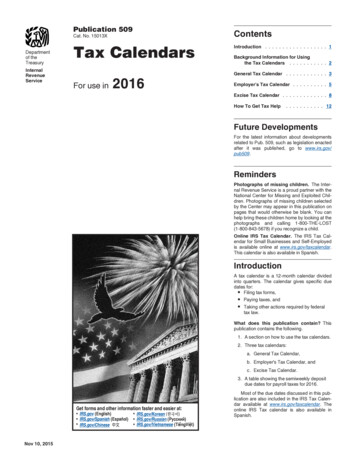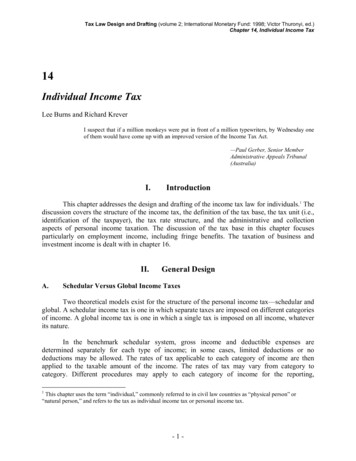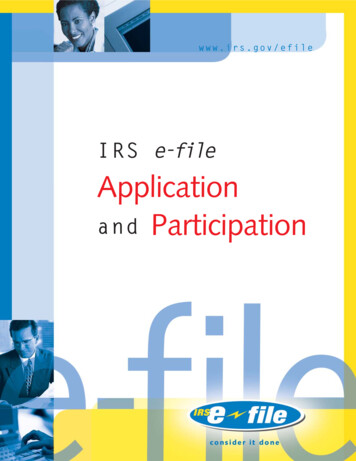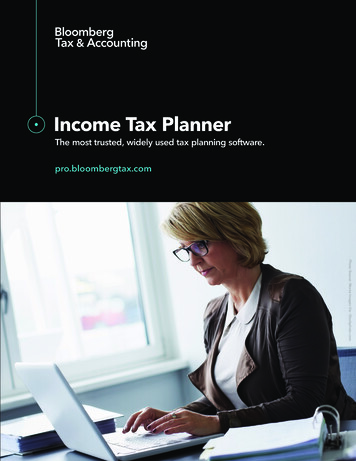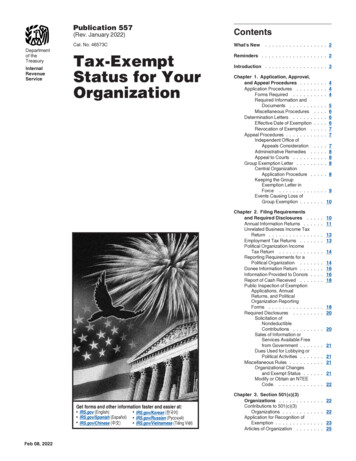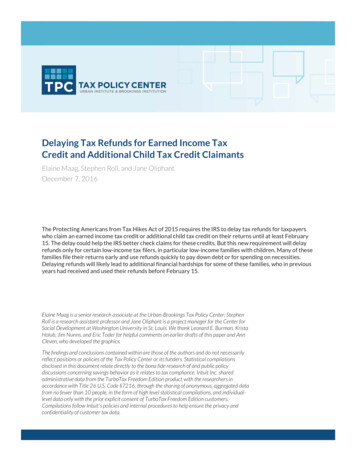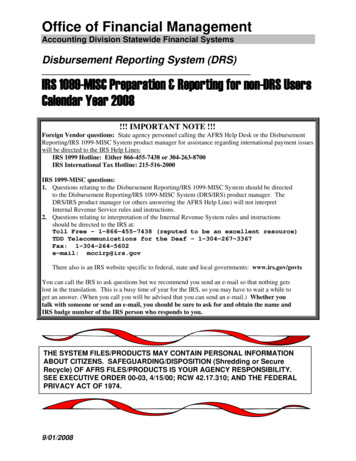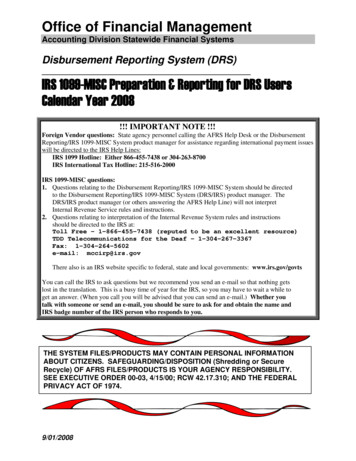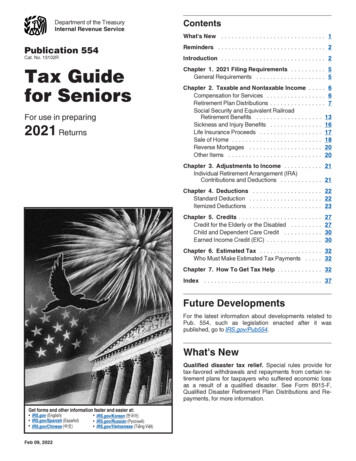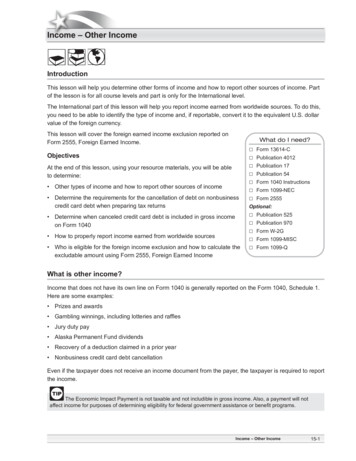
Transcription
Income – Other IncomeIntroductionThis lesson will help you determine other forms of income and how to report other sources of income. Partof the lesson is for all course levels and part is only for the International level.The International part of this lesson will help you report income earned from worldwide sources. To do this,you need to be able to identify the type of income and, if reportable, convert it to the equivalent U.S. dollarvalue of the foreign currency.This lesson will cover the foreign earned income exclusion reported onForm 2555, Foreign Earned Income.What do I need?ObjectivesAt the end of this lesson, using your resource materials, you will be ableto determine: Other types of income and how to report other sources of income Determine the requirements for the cancellation of debt on nonbusinesscredit card debt when preparing tax returns Determine when canceled credit card debt is included in gross incomeon Form 1040 How to properly report income earned from worldwide sources Who is eligible for the foreign income exclusion and how to calculate theexcludable amount using Form 2555, Foreign Earned Income Form 13614-CPublication 4012Publication 17Publication 54Form 1040 InstructionsForm 1099-NECForm 2555Optional: Publication 525Publication 970Form W-2GForm 1099-MISCForm 1099-QWhat is other income?Income that does not have its own line on Form 1040 is generally reported on the Form 1040, Schedule 1.Here are some examples: Prizes and awards Gambling winnings, including lotteries and raffles Jury duty pay Alaska Permanent Fund dividends Recovery of a deduction claimed in a prior year Nonbusiness credit card debt cancellationEven if the taxpayer does not receive an income document from the payer, the taxpayer is required to reportthe income.The Economic Impact Payment is not taxable and not includible in gross income. Also, a payment will notaffect income for purposes of determining eligibility for federal government assistance or benefit programs.Income – Other Income15-1
If you are unsure about sources of other income, consult the Volunteer Resource Guide, Tab D, Income,and Publication 17, Other Income, or discuss the income item with your Site Coordinator.Use the interview techniques and tools discussed in earlier lessons to ensure that all taxable income hasbeen included.Health Savings Accounts (HSA)HSA distributions not used to pay or reimburse the taxpayer for qualified medical expenses are generallyreported as additional income on Form 1040, Schedule 1. This topic is not covered in this lesson, it iscovered in the Adjustments lesson.What are some examples of other income?Gambling WinningsThe taxpayer may receive one or more Forms W-2G reporting gambling winnings. Total gambling winningsmust be reported as other income. If the taxpayer also had gambling losses, the losses can only bededucted on Schedule A. See the Itemized Deductions lesson for more details.Tax Software Hint: To review information related to reporting gambling income, go to the VolunteerResource Guide, Tab D, Income, Income Quick Reference Guide.Cash for Keys ProgramCash for Keys Program income, which is taxable, is income from a financial institution, offered to taxpayers toexpedite the foreclosure process. The taxpayers should receive Form 1099-MISC with the income in Box 3.Penal IncomeAmounts received for work performed while an inmate is in a penal institution aren’t earned income for theearned income credit. This includes amounts received for work performed while in a work release programor while in a halfway house. Any amount received for work done while an inmate in a penal institution isincluded in wages. See the Volunteer Resource Guide, Tab D, Income, for instructions on entering penalincome in the software.Under the PATH Act, a wrongfully incarcerated individual does not include in income any civil damages,restitution, or other monetary award received that relates to his or her incarceration.Qualified Medicaid Waiver PaymentsQualified Medicaid waiver payments may be excluded from gross income. To be qualified Medicaid waiverpayments, the care provider and the care recipient must reside in the same home. When the care providerand the care recipient do not live together in the same home, the Medicaid waiver payments are fullytaxable.A taxpayer may choose to include qualified Medicaid waiver payments in the calculation of earned incomefor the earned income credit (EIC) and the additional child tax credit (ACTC). The taxpayer may includequalified Medicaid waiver payments in earned income even if the taxpayer chooses to exclude thosepayments from gross income. A taxpayer may not choose to include or exclude only a portion of qualified Medicaid waiver payments.Either include all or none of the qualified Medicaid waiver payments for the taxable year in earnedincome. If the taxpayer chooses to include qualified Medicaid waiver payments in earned income, that amountwill be included in the calculation for both the EIC and the ACTC.15-2Income – Other Income
Refer to the Volunteer Resource Guide, Tab D, Income, Entering Medicaid Waiver Payments.Are distributions from ABLE accounts taxable?A qualified ABLE program is a program established and maintained by a state agency under which aperson may make cash contributions to an ABLE account to pay for the qualified disability expenses of aneligible individual (the designated beneficiary). Qualified beneficiaries can have only one ABLE account.Contributions are made in after-tax dollars and can be made by any person. Contributions must be made incash and are not deductible for federal income tax purposes.Distributions from an ABLE account that do not exceed the qualified disability expenses of the beneficiaryduring the taxable year are excluded from gross income. A distribution from an ABLE account that exceedsthe qualified disability expenses of the beneficiary is included in the beneficiary’s gross income and issubject to an additional tax of 10% imposed on the amount not used for qualified disability expenses.Taxable distributions from ABLE accounts are out of scope for the VITA/TCE programs.Qualified disability expenses include: education, housing, transportation, employment training and support,assistive technology and personal support services, health, prevention and wellness, financial managementand administrative services, legal fees, expenses for oversight and monitoring, funeral and burial expenses.Form 1099-QA, Distributions from ABLE Accounts, is used to report distributions from an ABLE Account.Are distributions from an Educational Savings Account (ESA), such as a Coverdell ESAand a 529 plan, taxable?Distributions from Coverdell ESAs and Qualified Tuition Plans (QTPs) are reported on Form 1099-Q,Payments From Qualified Education Programs (Under Sections 529 and 530). Coverdell ESA distributionscan be used to pay for qualified elementary, secondary, and postsecondary expenses. QTP distributionsmay also be used for qualified educational expenses for elementary and secondary public, private,and religious schools of up to 10,000 per year for each qualified beneficiary, certain expenses of anapprenticeship program, and the principal or interest on a qualified education loan up to a lifetime limit of 10,000 per beneficiary.A portion of the distributions is generally taxable to the beneficiary if the total distributions are more thanthe beneficiary’s adjusted qualified education expenses for the year. Qualified education expenses arediscussed in more detail in the Education Credits lesson.The taxable portion is the amount of the excess distribution that represents earnings that have accumulatedtax free in the account. The taxable amount must be reported as other income on the tax return. Taxabledistributions from ESAs and QTPs are out of scope.For additional information about educational savings accounts, distributions, and qualified educationexpenses, refer taxpayers to Publication 970, Tax Benefits for Education.An American opportunity credit or lifetime learning credit or tuition and fees deduction (if extended) can beclaimed in the same year the beneficiary takes a tax-free distribution from a QTP or Coverdell ESA, as long as thesame expenses are not used for both benefits. See Publication 17 and Publication 970, Tax Benefits for Education,for more details.Is a recovery taxable?Reimbursement in a later year for medical or other expenses deducted in an earlier year must be reportedas income up to the amount previously deducted as medical or under another provision. However, do notreport as income the amount of reimbursement received up to the amount of the prior year deductions thatdid not reduce the tax for the earlier year.Income – Other Income15-3
Cancellation of Debt – Nonbusiness Credit Card DebtCancellation of Debt – BasicsA debt includes any indebtedness for which a taxpayer is liable or which attaches to the taxpayer’s property,such as auto loans, credit card debt, medical care, professional services, mortgages, and home equityloans. Generally, if a debt for which a taxpayer is personally liable is canceled or forgiven, the taxpayermust include the canceled amount in income. There is no income from canceled debt if the cancellation orforgiveness of debt is a gift or bequest.Use Form 13614-C, Intake/Interview & Quality Review Sheet, to determine if the taxpayer received one orboth of Forms 1099-C, Cancellation of Debt, or 1099-A, Acquisition or Abandonment of Secured Property.Refer to the Legislative Extenders section for possible exclusion of cancellation of debt income on a mainhome.Taxability of Canceled DebtTaxpayers often question the taxability of canceled debt because they did not receive money in hand.In situations where property is surrendered, such as a foreclosure, taxpayers feel that by giving up theproperty they are relieved from any further obligation. Explain that the benefit to the taxpayer is therelief from personal liability to pay the debt. Information in Publication 17, Your Federal Income Tax forIndividuals, can assist with the explanation. Refer to Publication 4681, Canceled Debts, Foreclosures,Repossessions, and Abandonments.Generally, when debt is canceled, the lender will issue Form 1099-C, Cancellation of Debt, which is thenreported as income by the recipients on their tax return. There are exceptions and exclusions to the generalrule that determines whether a canceled debt is included as income. This is covered in greater detail in theLegislative Extenders lesson and later in this lesson.Form 1099-CGenerally, if a taxpayer receives Form 1099-C for canceled credit card debt and was solvent (assetsgreater than liabilities) immediately before the debt was canceled, all the canceled debt will be included onthe tax return as other income.Sometimes, Form 1099-C will show an interest amount in Box 3. Because only nonbusiness credit carddebt income is in scope, any interest on the account would not have been deductible. The amount shown inBox 3 is included in Box 2; therefore, the full amount shown in Box 2 should be reported as other income.exampleJohn made a deal with his credit card company to pay 2,000 on his 7,000 balance, and the companyagreed to take it as payment in full. In January of the current year, John received a Form 1099-C fromhis credit card company reporting 5,000 (the amount of debt canceled). John was solvent immediatelybefore the debt was canceled. John must include the entire 5,000 as other income on his tax return.Lenders and creditors are required to issue Form 1099-C if they cancel a debt of 600 or more. If the debtcanceled is less than 600, some lenders or creditors may send a letter or some other form of notification tothe taxpayer. Generally, taxpayers must include all canceled amounts (even if less than 600) in income.15-4Income – Other Income
Insolvency (Out of Scope for VITA/TCE)Insolvency is a condition in which the fair market value (FMV) of all assets is less than one’s liabilities. Theamount or level of insolvency is expressed as a negative net worth.For purposes of determining insolvency, assets include the value of everything owned (including assets thatserve as collateral for debt and exempt assets which are beyond the reach of creditors under the law, suchas an interest in a pension plan and the value of a retirement account).Liabilities are amounts owed and include: The entire amount of recourse debts The amount of nonrecourse debt that is not in excess of the FMV of the property and is security for the debtRefer to the Insolvency Determination Worksheet in the Volunteer Resource Guide, Tab D, Income, as aresource. Taxpayers must determine if they are considered insolvent.If the taxpayer had nonbusiness credit card debt canceled, all or part of the debt may be excluded if thecancellation occurred in bankruptcy, or if the taxpayer was insolvent immediately before the cancellation. Thesesituations are beyond the scope of VITA/TCE. If any of these situations apply, refer the taxpayer to a professional taxpreparer. See IRS Publication 4681, Canceled Debts, Foreclosures, Repossessions, and Abandonments, for moreinformation.Publication 4731, Screening Sheet for Volunteers Assisting Taxpayers with Form 1099-C, located in theVolunteer Resource Guide, Tab D, Income, provides step-by-step guidance for the volunteer tax return preparer todetermine if the cancellation of credit card debt is within scope.Taxpayer Interview and Tax Law ApplicationHere is how a volunteer advised Michelle regarding her canceled credit card debt.SAMPLE INTERVIEW.VOLUNTEER SAYS MICHELLE RESPONDS I notice you received a 1099-C from a credit card company.Yes, I negotiated with them to cancel 3,000 of my debt.Yes, Form 1099-C shows the amount of debt discharged.I could only afford to pay them 1,000,so it really helped me.Do you think your debts at the time exceeded your assets?I’m not sure, but it’s certainly possible.Let’s fill out the Insolvency Determination Worksheet to help usdetermine whether you were insolvent.OK.According to the worksheet, you are insolvent. I am afraid I amnot able to help you. VITA/TCE volunteers are not trained tocompute the nontaxable portion of canceled credit card debt.Oh, I understand.I suggest you seek assistance from a professional tax preparer.I will, thank you.Income – Other Income15-5
EXERCISESQuestion 1: Greg was released from his obligation to pay 5,000 of personal credit card debt. Thecredit card company sent Form 1099-C showing canceled debt of 5,000. Greg is fairly certain he hasmore debt than he has assets.Can the VITA/TCE site provide tax return preparation assistance to Greg?A. Yes, since the entire 5,000 in canceled debt is considered income and reported on Form 1040.B. No, because it appears Greg is insolvent, which might mean some of the canceled credit card debtwould be nontaxable and beyond the scope of the VITA/TCE programs.Question 2: Kay was released from her obligation to pay personal credit card debt. She owed 10,000to her credit card company, which agreed to accept 2,500 as payment in full. Before paying thecredit card company, it was determined Kay was solvent (assets greater than liabilities) and not inbankruptcy. The credit card company issued Kay a Form 1099-C, reporting 7,500 as the amount ofdebt discharged.Based on the information above, can Kay be assisted at her local VITA/TCE site? Yes NoQuestion 3: Review the information in Question 2 about Kay’s canceled debt. If the VITA/TCE site isable to assist Kay, what amount would be reported on Kay’s Form 1040?A. 0B. 10,000C. 2,500D. 7,50015-6Income – Other Income
What is worldwide income?U.S. citizens and U.S. resident aliens are required to report worldwide income on a U.S. tax returnregardless of where they live and even if the income is taxed by the country in which it was earned. Filingrequirements are the same as for U.S. citizens and U.S. resident aliens living in the United States and applywhether income is from within or outside the U.S.U.S. citizens and U.S. resident aliens living abroad may be able to claim tax benefits such as the foreignearned income exclusion or the foreign tax credit. This part of the lesson covers the foreign earned incomeexclusion. The foreign tax credit will be covered in another lesson.exampleIn the current year, Alfredo Kendall earned 40,000 while working in Dallas, Texas, for Dade Corporation.In September of this year, he transferred to their office in Stuttgart, Germany. While in Germany, heearned 30,000 (U.S. dollars). All of Alfredo’s wages, including the income he earned in Germany, isincluded in his gross income. His Form 1040 will show 70,000 in wages.Income is treated the same on the return regardless of the country from which it is derived. Similar incomeearned inside or outside the U.S. is generally taxed in the same way on the return. Likewise, income earnedin the U.S. and not taxed will be treated in the same way if earned outside the U.S. The lines on whichincome is reported on Form 1040 are the same whether the U.S. citizen or U.S. resident alien is living withinor outside U.S. boundaries.Foreign income might be reported to taxpayers on forms or in ways that are not used in the United States.Question taxpayers closely to ensure that they are reporting all worldwide income. Review the income records toensure that includible amounts are accurate and complete.Taxpayers with foreign income, bank accounts, or assets may have additional filing responsibilities, which areout of scope. See Schedule B and Form 8938 for additional information.Tax Software Hint: To review information related to income from a foreign employer, go to theVolunteer Resource Guide, Tab D, Income.Income – Other Income15-7
EXERCISES (continued)Answers are listed following the lesson summary.Question 4: Marta Bremer, a U.S. citizen, lives in Mussbach, Germany. Her income included 22,000in wages earned in Germany. She earned 300 in interest from her U.S. bank. What is Marta’s totalincome?A. 0B. 22,300C. 300D. 22,000Question 5: Mary Carleton, a U.S. citizen, lives in Belgium. Her income included 10,000 in wagesfrom her Belgian employer, 200 in interest from her U.S. bank, 8,000 in gambling winnings, and 7,000 in child support payments from her ex-spouse. What is Mary’s gross income?A. 8,000B. 10,200C. 18,200D. 25,200How do I convert foreign income to U.S. dollars?Exchange ratesAll amounts on the U.S. tax return must be stated in U.S. dollars. Convert income that taxpayers receivedin foreign currency into U.S. dollars using the appropriate exchange rate. U.S. exchange rates are stated intwo ways: Units of foreign currency to one U.S. dollar: 0.74855 Euro 1 U.S. dollar U.S. dollars to one unit of the foreign currency: 1.33592 U.S. dollar 1 EuroExchange rates shown here are for example only. Use the exchange rates in effect when the income wasreceived.To convert a sum of money into U.S. dollars, divide the amount of foreign currency by the exchange rate forthe foreign currency to one U.S. dollar.exampleRyan received 3,000 Euros ( 3000) on a day that the exchange rate was 0.74855 Euros to one U.S.dollar. Based on this exchange rate, the value of Ryan’s 3000 is: 3000 0.74855 4,007.7515-8Income – Other Income
In other words:Amount of foreign currencyExchange rate of foreign currency to one U.S. dollar3,000 Euros0.74855 Amount in U.S. dollars 4,007.75EXERCISES (continued)Question 6: Caryn received 200 Euros on a day that the exchange rate was .75514 Euros to one U.S.dollar. In U.S. dollars, she would have .A. 264.85B. 377.57C. 115.03D. 11.50Question 7: Given an exchange rate of .7000, how much is 36,000 Euros worth in U.S. dollars?A. 252.00B. 25,200.00C. 51,428.57D. 61,614.00Which exchange rate should I use?The exchange rate for a particular currency is likely to change every day. Use the exchange rate prevailingwhen the taxpayer receives the pay or accrues the item. The exchange rate is determined by the dateof transaction, which is either the date on the check or the date the money is credited to the taxpayer’saccount. If there is more than one exchange rate, use the one that most properly reflects the income.However, the taxpayer can use the average annual exchange rate if: Foreign income was received evenly throughout the year, and The foreign exchange rate was relatively stable during the yearTaxpayers may use the monthly average exchange rates if they earned foreign income evenly for one ormore months, but less than twelve months.exampleEdward Hall worked in Dallas for Lubbock Incorporated from January until September. On September29, he was transferred to Lubbock’s Mexico City office, where he will be working for three more years.In Mexico, he is paid in Mexican pesos. Because he did not receive his salary in Mexican pesos evenlythroughout the year, he cannot use the annual average exchange rate for Mexico source income. If hedoes not know the exchange rate at the time he received the funds, he can use the monthly averageexchange rate for October, November, and December.Income – Other Income15-9
Where to obtain exchange ratesIn mid-January, the IRS distributes exchange rates for various currencies to its worldwide offices, includingthe prior year’s average annual exchange rate information.Exchange rates can be found at irs.gov by typing “foreign currency rates” in the search box. You may alsocontact banks that provide international currency exchange services.Because taxpayers should use the rate that most closely reflects the value of the foreign currency at thetime they receive the income, taxpayers may use an exchange rate that is different from the rates posted inIRS worldwide offices if they find it to be a true representation.What is the foreign earned income exclusion?Use Form 2555 to claim the foreign earned income exclusion. Certain taxpayers can exclude incomeearned in, and while living in, foreign countries. The maximum amount of the foreign earned incomeexclusion is indexed to inflation annually. For the current year amount go to irs.gov or Publication 17. Theforeign earned income exclusion does not apply to wages and salaries of U.S. military members andcivilian employees of the U.S. government.If the taxpayer qualifies to exclude foreign earned income, the excludable amount will be reported as anegative amount on the other income line of Form 1040, Schedule 1. Since the foreign earned income wouldhave been reported on Form 1040 as taxable wages or as self-employment income, the exclusion (negativeamount) will reduce the total income calculated. The method of calculating the tax when the taxpayer electsthe foreign earned income exclusion is based on the Foreign Earned Income Tax Worksheet. The taxsoftware will do this calculation automatically.If a taxpayer elects to exclude foreign earned income, he cannot claim the earned income credit and therefundable portion of the child tax credit. The child and dependent care credit does not include excluded foreignincome as earned income when computing the credit.Tax Software Hint: To review information related to the software for the foreign earned incomeexclusion, go to the Volunteer Resource Guide, Tab D, Income.When do I choose the exclusion?The foreign earned income exclusion is voluntary. It is not always an advantage to claim the exclusion. Iftaxpayers wish to claim the exclusion, they must file Form 2555 with a timely return (including extensions).If the taxpayer is not eligible for the foreign earned income exclusion, any taxes paid on this income to aforeign government may be eligible for the foreign tax credit. See the lesson Foreign Tax Credit for moreinformation.Once the taxpayer chooses to exclude foreign earned income, that choice remains in effect for that yearand all later years until revoked. The taxpayer may revoke the exclusion for any tax year by attaching astatement to the return. When the exclusion is revoked, the taxpayer may not claim the exclusion again forthe next five tax years without the approval of the IRS.What are the eligibility requirements?To claim the foreign earned income exclusion, taxpayers must: Demonstrate that their tax home is in a foreign country Meet either the bona fide residence test or the physical presence test Have income that qualifies as foreign earned income15-10Income – Other Income
The requirements are applied separately to each individual. If a married couple is working overseas, eachspouse must meet all requirements to qualify for the exclusion. If they do qualify, each is entitled to anexclusion of up to the maximum amount for the current year.The terms foreign, abroad, and overseas do not include Puerto Rico, U.S. Virgin Islands, American Samoa,Guam, the Commonwealth of the Northern Marianas, Wake Island, the Midway Islands, and Johnston Island.EXERCISES (continued)Question 8: Miranda has lived in Puerto Rico since 2003. Is she eligible for the foreign earned incomeexclusion? Yes NoHow do I determine the tax home?To claim the foreign earned income exclusion, the taxpayer’s tax home must be in a foreign country. The taxhome is defined as the country in which the taxpayer is permanently or indefinitely engaged to work as anemployee or a self-employed individual, regardless of where the family home is maintained.For taxpayers who work abroad but do not have a regular place of business because of the nature of thework, their tax home is the place where they regularly live. The tax home for members of the U.S. ArmedForces is the permanent duty station, either land-based or on a ship.exampleJohn and Mary are both in the Armed Forces and have been permanently stationed in Germany sinceAugust 2007. Their tax home for the current year is Germany.EXERCISES (continued)Question 9: Alan has lived and worked in China since August 16, 2005. China is his tax home. True FalseWhat is a regular place of abode?For purposes of the foreign earned income exclusion, if taxpayers work overseas for an indefinite period oftime, and their regular place of abode is the U.S., the taxpayers cannot designate the foreign country as thetax home.“Regular place of abode” is defined as one’s home, habitation, domicile, or place of dwelling. It does notnecessarily include one’s principal place of business.If the taxpayer maintains a place of business, or is assigned to overseas employment in a foreign countryfor an indefinite period, and does not maintain a regular place of abode in the U.S., the tax home isoverseas and the taxpayer may be eligible for the foreign earned income exclusion.Income – Other Income15-11
How do I determine whether the U.S. is the taxpayer’s regular place of abode?Ask three questions to determine whether a U.S. home is the taxpayer’s regular place of abode:1. Did you use your home in the U.S. as a residence while you worked at your job in the U.S. just beforegoing abroad to your new job, and did you continue to maintain work (e.g., contacts, job seeking, leaveof absence, ongoing business) in that area in the U.S. during the time you worked abroad?2. Are your living expenses duplicated at your U.S. and foreign homes because your work requires you tobe away from your U.S. home?3. Do you have a family member or members living at your U.S. home, or did you frequently use your U.S.home for lodging during the period you worked abroad?If the answer to two of the questions is “no,” the taxpayer is considered to be indefinitely assigned to thenew location abroad and is eligible for the foreign earned income exclusion.If the answer to all three questions is “yes” and the job duration is for less than one year with the taxpayerreturning to the U.S. home, the taxpayer is considered “temporarily away” from home. In this case, thetaxpayer does not qualify for the foreign earned income exclusion, but may qualify to deduct away-fromhome expenses.If the answer to two of the three questions is “yes,” with the same expectation of job duration and return tothe U.S. home, the location of the tax home depends on the facts and circumstances.exampleHenry is a member of the Armed Forces. He was assigned to a post in Japan last year. This assignmentwas for an indefinite period that exceeds one year. Margaret, his wife, accompanied him to Japan andhas foreign earned income. They have not used their home in the U.S. as a place of residence for over ayear. Therefore, their tax home for this year is Japan.EXERCISES (continued)Question 10: Stan is employed on an offshore oil rig in the territorial waters of a foreign country andworks a 28-day on/28-day off schedule. He returns to his family residence in the U.S. during his offperiods. Does Stan’s employment satisfy the tax home test? Yes NoWhat is the period of stay requirement?The period of stay is the amount of time the taxpayer stays in the foreign country. To meet the period of stayrequirement, the taxpayer must be either: A U.S. citizen or U.S. resident alien from a tax treaty country who is a bona fide resident of a foreigncountry (or countries) for an uninterrupted period that includes an entire tax year, or A U.S. citizen or U.S. resident alien who is physically present in a foreign country or countries for atleast 330 full days during any period of 12 consecutive monthsRevenue Procedure 2020-27 provides that the Secretary of the Treasury has determined that the globalhealth emergency caused by the outbreak of COVID-19 is an adverse condition that precludes the normal conductof business globally. Therefore, relief is being provided to any individual who reasonably expected to become a“qualified individual” for purposes of claiming the foreign earned income exclusion under section 911, but left theforeign jurisdiction during the period described in this revenue procedure.15-12Income – Other Income
What i
such as auto loans, credit card debt, medical care, professional services, mortgages, and home equity loans. Generally, if a debt for which a taxpayer is personally liable is canceled or forgiven, the taxpayer must include the canceled amount in income. There is no income from canceled debt if the cancellation or


